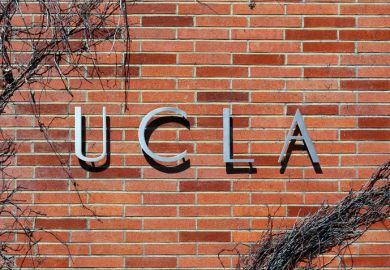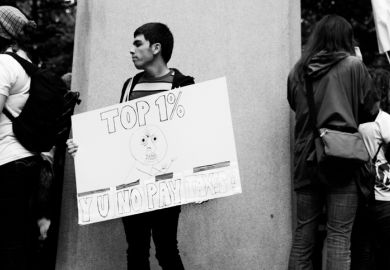Source: Getty
We are finding cases of universities trying to restrict unions - saying that they will give them money, but that things have to be done a certain way. That is very uncomfortable
At the turn of the century, students’ unions were still enjoying something of a heyday. It was a golden era for campus drinking, partying and spending – meaning unions could rely heavily on the income generated by their plentiful patrons.
Fast-forward 14 years, and the picture has changed – and is still changing – dramatically. Students, if you believe the bar sales receipts, are not drinking as much. At least not in the union bars, whose sales have declined steadily for more than a decade. In 2007, Matt Hyde, then chief executive of the National Union of Students, reported a 46 per cent drop in bar sales over the preceding decade. The trend has since slowed, but it continues. According to recent NUS data, there has been a further 5 per cent fall in licensed trade sales in the past five years, and sales of draught beer, cider and alcopops have slipped by 19, 24 and 69 per cent, respectively, although the overall decline has been mitigated by sales of bottled cider and spirits.
Among the factors that have motivated students’ unions to rethink business plans and refocus strategies are increased competition from town centre venues and an influx of study-conscious undergraduates determined to ensure that their student loans are spent on academic development rather than 2am taxis.
“When I was students’ union president, our annual turnover was around £5 million and our grant from the university was probably around £1 million,” recalls Alex Bols, who was president of the University of Southampton students’ union in the late 1990s, spent five years at the National Union of Students and will next month join GuildHE as deputy chief executive.
Financial data for Southampton’s students’ union show that a third of its income in the 2011-12 financial year came from the university via a block grant of just over £2.4 million.
Jim Dickinson, chief executive of the Union of University of East Anglia Students and a former president of the University of the West of England students’ union, believes that students’ unions are becoming increasingly reliant on these block grants and other funds paid to them by the central university.
“Student lifestyle and behaviour has changed, so there’s very little evening drinking going on and it’s kind of taboo to drink on campus during the day,” he says of his own union. “Almost all unions in the higher education sector have gone through a business model reinvention. While some have diversified into things like coffee or other types of retail away from bars and clubs, the reality is that…unions today have started to focus more on academic representation.”
There has – on paper at least – been a significant increase in the amount of catering trade that unions are doing, with such sales up 34 per cent in the past five years, according to NUS figures.
Raechel Mattey, NUS vice-president with responsibility for union development, says the decline in alcohol sales has forced unions to innovate in order to maintain revenue.
“There are a whole host of other services coming through such as job shops, letting agencies, computer repair shops, coffee shops and juice bars,” she says. “There is a changing face of student demand, and that’s been reflected.”
For example, Aberystwyth University students’ union has closed one of its union bars and plans to introduce new services including a learning centre and a letting agency.
But commercial operations cost money to run, and figures from some of the biggest unions in the UK suggest that sales do not necessarily translate into profit.
Accounts for the Edinburgh University Students’ Association (the equivalent of a union), for example, record a “net deficit of £368,130 on trading activities” in the 2011-12 financial year. However, the deficit was £78,600 smaller than that recorded for the previous year.
At the University of Sheffield, union figures for 2010-11 show that despite a trading turnover of about £8.5 million, commercial activities contributed just £818,482 to the union purse. The accounts also reveal that grants from the university (worth £2.4 million in 2011) made up 74 per cent of the union’s total available income in 2011, compared with 60 per cent in 2009 and just 49 per cent in 2006.
In addition to the changing mindset of students, a number of national policy changes have forced unions to adapt, with the result that universities have started to take a far more active interest in how they operate.
The Charities Act 2006 required students’ unions with annual incomes of more than £100,000 to register separately with the Charity Commission. Most became designated educational charities, and thus had to justify their educational purpose. Unions offering little more than beer and clubbing might not impress the commission if it came knocking, so unions had to ensure that they were offering a more valuable service to their members.
Meanwhile, for universities, rising tuition fees meant that students’ expectations began to increase, and it was no longer acceptable to have a union building offering plenty in the way of shops and bars, but little in the way of support services. In addition, from 2012, a question was added to the National Student Survey asking respondents to what extent they agreed with the statement: “I am satisfied with the Students’ Union (Association or Guild) at my institution.” Suddenly, the effectiveness of a union’s activities was having a much more pronounced impact on the reputation of the university to which it was aligned.
“It feels as though over the past five years or so, unions have got better at engaging a much larger proportion of the whole student population,” Bols says. “They are getting a lot slicker at what they are doing, and the institutions are responding to that.”
Bols agrees that universities are now the main source of income. “I’d say around 90 to 95 per cent of students’ unions’ disposable income comes from the university.”
This is certainly the case at London South Bank University, which no longer operates its own bar services at all after outsourcing bar and catering operations to contract caterers Elior. Steve Baker, the chief executive of LSBU’s students’ union, is overhauling operations to move the organisation away from retail and towards what he sees as its primary focus: representing students’ needs. This, he hopes, will ensure that the union continues to receive adequate funding from the university.
“We have become heavily reliant on our block grant,” he explains. “If the [university is] going to give [us] more money, it needs to know that what we’re doing is good.”
But does such financial dependence limit students’ unions’ powers to independently campaign and, when necessary, challenge the university on behalf of the student body? While Mattey agrees that a positive relationship between the university and the union is mutually beneficial, she is concerned that if unions become overly reliant on institutional funding, their independence could be compromised.
“We don’t want to get to the point where universities are restricting unions or telling them what they can and can’t spend their money on. We have to make sure that unions are strong, democratic and autonomous bodies,” she says.
“We are finding cases of universities trying to restrict [unions] – saying that they will give them money, but that things have to be done a certain way. That’s something that is very uncomfortable, that we shouldn’t be allowing.”

Being too cosy with universities could, in theory, mean that unions risk jeopardising the effectiveness of some of their most important functions – such as advocating on behalf of students with grievances and offering independent advice to those who take issue with the behaviour of their university.
Last year, the University of Edinburgh amended a contract that had required its university students’ association to give two days’ notice if it intended to say or publish anything that could be “detrimental” to the university. The clause, inserted in the contract covering the £2.3 million grant from the university to the EUSA, was dubbed a “gagging clause” by some students. At the time, the university said: “We take the welfare of our students very seriously and have always enjoyed a positive working relationship with their elected representatives. In the light of recent discussions with the students’ association, we have agreed to amend the contract to remove the requirement for advance notification.”
“There is the danger of a chilling effect,” Dickinson says, “when students’ union officers are in a meeting with people from the university, and item one on the agenda is ‘can we get a substantial block grant?’, but item two is ‘can we fall out with you over an issue?’.”
Critical here, he says, is an ability to accentuate the positives while not backing away from the negatives. “The NUS is very careful to make sure officers are prepared to be honest and assertive about how the union contributes to the student experience and needs a grant, while making sure they are still able to raise concerns and have a pop at the university when they need to.”
Some students’ unions have won major increases in funding from their university in recent years.
The University of Northampton students’ union has seen its block grant grow from £519,000 in the 2008-09 academic year to just over £1.1 million for 2012-13 (although the grant peaked at just over £1.3 million in the previous year).
According to Kane Roderique-Walker, vice-president of student experience at the union, winning over the university’s vice-chancellor, Nick Petford, was a key part of ensuring the union’s financial stability in the face of falling commercial revenues.
“The vice-chancellor saw that a lot of the money we had wasn’t being spent in what he felt were the right places,” Roderique-Walker says. “Essentially what he wanted from us was to better the student experience. A few years ago we had very few societies, very few people taking part in sport. Now we’ve got over 50 affiliated societies – a 392 per cent increase in the past two years.”
One of the ways that Northampton’s students’ union is looking to boost its commercial returns, and ensure that students spend their money in the union, is by providing free access to sports to build a sense of affiliation between it and students. This approach is being adopted by a number of unions.
“We’re hoping we can get some allegiance or loyalty to the students’ union that will mean that they want to spend money with us,” Roderique-Walker says. Another tactic being employed is offering a 50 per cent profit share to societies on any tickets for union events that they sell to their members.
Cari Davies is president of Cardiff University’s students’ union. At almost £2.4 million in 2012-13, its block grant is one of the biggest in the UK. She believes that students today tend to split into two groups. “There are those that – because they are paying a higher fee – are very, very focused on their studies, and won’t go out or do extracurricular things. But the larger cohort see the need to get more from their university experience, and that’s often related to the union – things like sports and societies, things that will boost employability.”
This places financial pressure on students’ unions, which are stretched by trying to offer more in the way of student services while catering for a more prudent student body.
At the University of Nottingham, Paul Greatrix, the university’s registrar, admits that Nottingham did have to think long and hard about increasing its students’ union’s block grant by £700,000, taking the total to £2.7 million for the 2013-14 academic year.
“We are squeezing our schools and central services while giving a significant increase to the union. How does that look?” Greatrix asks. “The thing is, they have made significant changes…There has been a real professionalisation of their activities – as well as a succession of very good elected officers.”
As at Northampton, Greatrix says, Nottingham has worked with the union to increase the quality of the services that it can offer students. Although he says that some students complained that this looked “like a university takeover” – Greatrix insists that it “absolutely wasn’t” – he believes that the benefits of a closer working relationship have far outweighed the negatives.
“In general, universities and unions seem to be working very closely – there was a concern that the Charities Act would push them further apart…but I think they’ve come closer together.”
This closeness was not quite so evident at the University of East Anglia early last year, however. After finishing top of Times Higher Education’s Student Experience Survey 2013, the union went on the attack – claiming that the university would never have obtained that standing were it not for the services offered by the students’ union, and that the union faced a block grant funding shortfall of £34,000 in 2012-13, meaning that it would soon be forced to cut some services and increase prices in the union.
A blog posting by student journalist Victoria Finan that highlighted the union’s predicament had one clear target. “At the moment, the Union are given £460,000 by the university – a poxy amount when compared to the £2.5 million University College London are given for example,” she wrote last April.
Union chief executive Dickinson says the organisation is “going through the business model reinvention” already witnessed on many other campuses. “Now, the university and the union are having more conversations about the ways in which the university can support the union. Some unions were having this conversation 10 years ago – although some have yet to have it,” he says.
One of the most obvious signs of universities’ keenness to bolster their reputations through increased union funding is the flurry of new union buildings on campuses across the UK.
Nottingham Trent University, for example, has invested £60 million in a new union building and new student accommodation, while the University of Sheffield has recently opened a £20 million base for its union. The University of Bristol plans to invest £30 million in refurbishing its union to “better fulfil our vision of students creating a world-class student life”, Bournemouth University is spending £10.5 million on a new student centre to house its union, and, in Scotland, the University of St Andrews will put £12 million into refurbishment. The list goes on.
“Institutions know that they need to invest in the services that students will be looking at when they come to open days,” Bols says, adding that an impressive union building or new sports facilities could influence students’ decisions about which university to attend.
As students’ unions continue to adapt to the era of high tuition fees, some people will continue to question the extent to which an organisation that gets the vast majority of its disposable income from a single source can be independent, while others see the evolution of a more civilised relationship, with union and university working towards a common goal.
“At some point, you need to feel the love from the other side,” Bols says. “The union needs to work with the institution, and that might mean that it sometimes feels like it can’t say what it wants. There are, however, increasing numbers of unions that have developed a real partnership with their institution and where the university welcomes the more independent ‘critical friend’ role that the students’ union can play as the sign of a mature, mutually beneficial relationship.”
Register to continue
Why register?
- Registration is free and only takes a moment
- Once registered, you can read 3 articles a month
- Sign up for our newsletter
Subscribe
Or subscribe for unlimited access to:
- Unlimited access to news, views, insights & reviews
- Digital editions
- Digital access to THE’s university and college rankings analysis
Already registered or a current subscriber? Login





